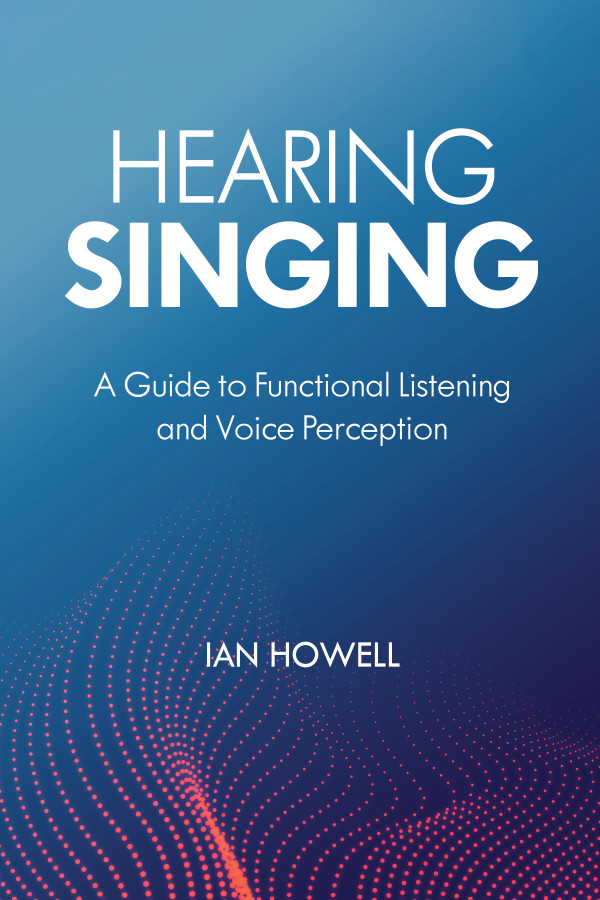The Singer’s Library: Hearing Singing

A new book explores sound perception as it applies to singing.
In the opening pages of his new book, Hearing Singing: A Guide to Functional Listening and Voice Perception (Rowman & Littlefield, 2025), author and pedagogue Ian Howell asks some straightforward questions: “How does one even begin to talk about the sound of a singing voice? Can one talk about it?” Far from rhetorical musings, Howell states that addressing those questions is the very purpose of the book.
Despite Howell’s wide-ranging career as a performer, teacher, and scholar, he is likely best known in pedagogical circles for his work in psychoacoustics, which he defines as the scientific field concerned with sound perception. In this new book, he explores how we create, understand, and experience sound, offering his perspectives on how voice acoustics can be used to guide singers toward efficient and expressive singing.
Hearing Singing seems to have been written for more than one audience. Can you talk about how you structured the book and who will get the most out of which parts?
This book is the result of about a decade of work as a classroom voice pedagogy teacher and performing arts researcher, more than 20 years as a voice teacher, and more than 30 years as a singer. I hope that each of those populations will get something important from the book. There are framing chapters, incredibly deep and challenging chapters, and completely practical chapters about voice teaching.
I think it is important to understand why the voice pedagogy literature looks like it does. The book opens with the idea that voice pedagogy borrows many ideas from the sciences, sometimes for good and sometimes for ill. I want readers to understand why that information is centered, and why they may be confused about what they read in textbooks. I then cover how the ear transduces sound and offer tools to understand how dependent our experience of timbre is on that process.
The middle chapters address timbre and voice perception at a level appropriate for a graduate seminar. This part of the book will challenge people to learn new things and change some assumptions about the voice. Those who work with singers, or singers who want to better understand their own singing body, will benefit from the last two chapters. This includes a chapter that explains how to teach singing and a chapter that lists exercises and predictable perceptual patterns that will emerge across your student population.
Finally, there is an appendix of labs (found at the companion website) and an appendix that explains how to read a waveform, spectrum, and spectrogram.
You propose “an actionable framework for hearing singing” that includes presenting simple ways of understanding the perception of sound that “can radically affect how we hear voices.” You have been writing about psychoacoustics for many years now. What led you to this field and your desire to explore its impact on how we teach singing?
I have spent a lot of time both trying to be a better voice teacher myself and trying to teach other people how to teach well. I think a lot about how Garcia II understood the material that flowed from his experiences with that dentist’s mirror. His aim was not to replace the voice teaching of the time. His aim was to bring efficiency to that process where it was inefficient. So I think about where inefficiencies arise in a voice lesson and as you attempt to train others to teach.
At its core, the aim of a voice lesson is to facilitate a change in a singer. That change should absolutely be grounded in the goals that singers have for themselves, but they are there to learn how to do new things or how to do old things in new ways. If that is true, the single most crucial skill set a teacher or coach must develop is their ability to hear whether that change has occurred.
There are reams of pedagogy books, few to none of which address how to listen. Few of them link what we hear to vocal function, and almost none of them presents a unified narrative that addresses the entire singing process from the moment the singer thinks to the moment the listener’s brain processes that stimulus and experiences the sound.
It is much easier to find pedagogy texts that go into great detail about all of the parts of the singing body that we can see, even if it means we must dissect a cadaver to see it. Or that explore measurable aspects of acoustical analysis visible on a computer screen. It is much easier to offload anything about the actual sound of singing to the voice studio and focus on more concrete facts in a textbook.
I would never argue that that information cannot help, but it does not automatically help. What voice teachers need is to hear what these things sound like and to be able to label those experiences for later recall. And they need to be able to hear with such detail that they can recognize the “sounds in progress” of their own singers.
Anyone who reads Hearing Singing will come away with specific labels to describe simple aspects of a singer’s sound. The perceptual experiences those labels point to may be linked directly back to specific functional adjustments. This means that these aspects of sound are both a sign that a specific function has been achieved, and also a prompt to elicit that function.
If you want to be an efficient and effective teacher or coach, the ideas in this book will fill in many gaps in the current literature.
You describe your intention to cover topics both academically and experientially, stating, “None of this journey was abstract for me. It was always about the sounds.” To that end, you include lessons and lab assignments on the companion website EmbodiedMusicLab.com. What do you hope readers will gain by using these online resources?
I am completely serious when I write this: My aim is to fundamentally rewire the way people’s brains process sound. There is an experiential layer of vocal timbre that follows very simple patterns and guardrails. There is no automatic ability to hear in this way, but if you train to hear it, these patterns will always be there.
You write that learning how to listen functionally will allow individuals to connect certain aspects of sung sound to specific physiological adjustments. In other words, we can make logical assumptions about what is happening within a singer’s body based on how that singer sounds. How long does it take to train functional listening skills? Are they useful for singers as well as voice teachers?
I had to draw some bright lines around the scope of this book at the outset. I am really writing to those who listen to singing conducted through air. The sensory scene of a singer is far more complex than that of a listener (although, most teachers also sing, so I suspect this book will enliven that experience as well).
I think it takes a remarkably short amount of time to train the ear to hear the qualities I lay out. Using spectral filters in an app like VoceVista Video or Praat can quickly point toward these opposable aspects of the sound. My brain is permanently rewired at this point, and I hear them in natural and urban sounds as well.

Review
Author Ian Howell offers two ways to utilize his book, Hearing Singing: A Guide to Functional Listening and Voice Perception. Those looking for “the deepest dive possible” can read it from start to finish, which will provide “a granular understanding of perceptual phenomena relevant to the singing voice.” For those with less background in voice science, he recommends reading the first two chapters and the final two chapters. This approach offers readers practical takeaways while also providing some of the background needed to tackle the other chapters.
Howell’s framework includes exploring how the ear plays a role in co-creating the sounds we perceive. He has devised exercises in the form of 25 lab assignments designed to help readers tune their ears to dependably identifiable aspects of timbre and perception. He then aims to highlight the functional elements that create those sounds which, once identified, can inform our choices in the voice studio.
The content of Hearing Singing is admittedly complex. As Howell explains, learning to listen functionally and to apply that knowledge to studio instruction “is not a quick fix that distills well to bite-size takeaways.” Even so, his tone throughout the book is one of encouragement. He advises readers not to get bogged down with terminology, especially in the lab assignments, which are intended to make concepts more experiential.
He also encourages teachers to stick to whatever language they use in the studio that allows students and clients to sing better. “I would be happy if one of my voice teaching mentees never spoke any of the words in this book in a lesson,” he says. “The ideas in this book are for the teacher to inform, to suggest, to predict, and to serve as guardrails.”
Howell acknowledges that it is bold for anyone to share their own points of view, believing they have come up with fresh ideas or novel ways of thinking. At the same time, he knows that the willingness to put personal perspectives out into the world is the only approach that moves our field forward. Readers of Hearing Singing, therefore, must be willing to challenge previous—possibly long-held—understandings, which is a necessary mindset whenever encountering innovative ideas.
Those who entertain what is presented, and who make the requisite aural investment, are sure to have what Howell describes as “an ear-opening experience.”
